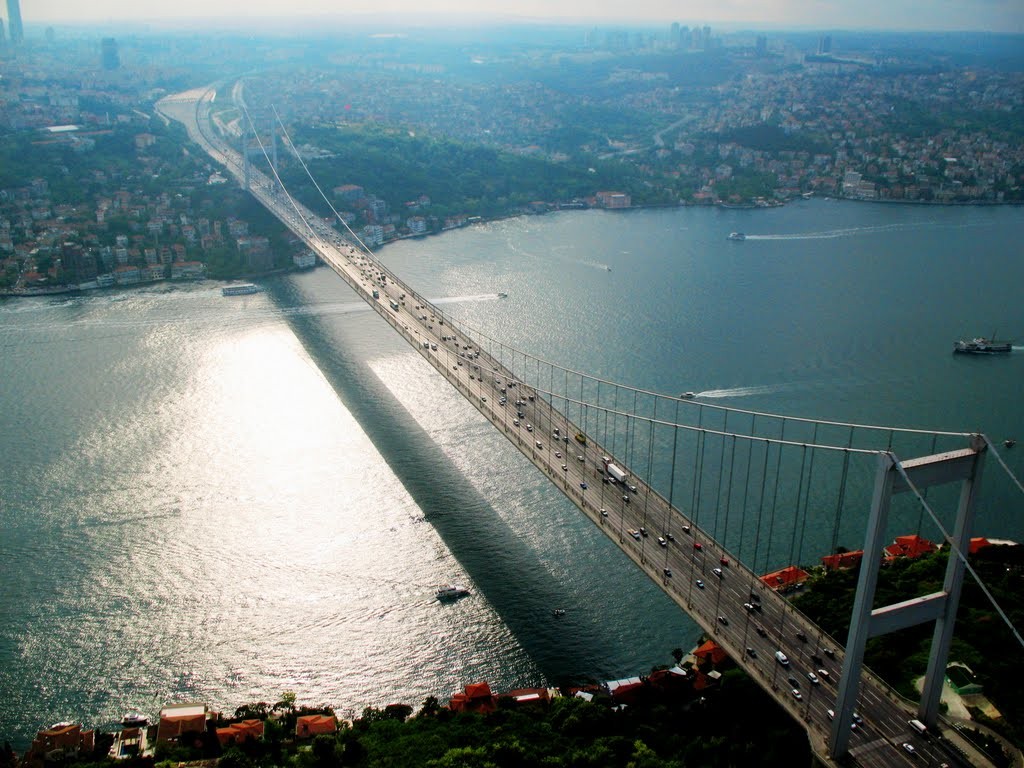Bosphorus Istanbul

Bosphorus
It is the name of the natural channel connecting the Black Sea and the Sea of Marmara. The Istanbul Strait divides the city of Istanbul into two parts, the European side and the Anatolian side, and is transported by means of bridges or by sea.
The Istanbul Strait is regarded as one of the natural borders that separates Europe and Asia. The shores of the Istanbul Bosphorus have been home to various civilizations throughout history and played a key role in the wars.
It is the only way out of the waters of the Black Sea, which is fed with three major rivers such as the Bosphorus, Danube, Dinyeper and Don and numerous small waters
Properties of the Istanbul Strait
- 1. The length is 29.9 km.
- 2. The largest is 3.6 km.
- 3. The narrowest point is 698 m.
- 4. The deepest place is 120 m.
- 5. Boğza extends in northeast-southwest direction.
- 6. The northern border of the Istanbul Strait forms the line connecting Anatolian Lighthouse to Rumeli Lighthouse.
- 7. The southern border of the Istanbul Strait forms the line connecting Ahırkapı Lighthouse to Kadıköy İnciburnu Lighthouse.
- 8. The amount of water flowing through the throat from the Black Sea to the Sea of Marmara is 660 billion cubic meters per year.
- 9. The average annual air temperature at the Bosphorus ranges from 13.6 ° C to 13.9 ° C.
The seas that the Istanbul Strait connects to one
The Black Sea and Marmara Sea.
What is the Bosphorus?
The settlement area spread on both sides of the Istanbul Strait is called Bosporus.
Bridges on the Bosporus
- 1. Bosphorus bridge
- 2. Fatih sultan mehmet bridge (Fsm)
How to get to Istanbul Bosphorus?
- 1. By roads over bridges,
- 2. With sea buses,
- 3. With ferries carrying cargo, vehicles and passengers,
- 4. With the city line ferry,
- 5. With passenger engines.
Where are the transports through the Bosporus?
- 1. Bulgaria
- 2. Georgia
- 3. Romania
- 4. Russia
- 5. Ukraine
- 6. Mediterranean
When was the sovereignty of the Istanbul Strait given to Turkey?
The sovereignty rights of the Bosphorus were given to Turkey in the light of certain rules by the Montreux Straits Convention signed on 20 July 1936.
Types of climates in the Bosporus?
In the Bosphorus, Mediterranean climate characteristics are generally seen. The summers are warm and dry; The climate of the Black Sea in addition to the Mediterranean climate where the winters are warm and rainy, and the continental climate of the Balkans and Anatolia are also influential in the water temperature of the Bosphorus and its surroundings. The temperature of the throat water is generally the same as the temperature of the air.
The most important hill overlooking the Istanbul Strait
The most important elevation overlooking the Bosphorus is Büyük Camlica Hill with a height of 252 meters and Küçük Camlica Hill with a height of 216 meters.
What is Marmaray?
The sinking tunnel, which passes under the Bosphorus, is the name of an iron road project designed to connect the two sides of the city.
Can it be swim along the Bosphorus?
According to the samples taken from various coasts, baby, tarabya, emirgan, caddebostan and so on along the throat. It is inconvenient to enter the sea because of the sea pollution in the seas.
Stands in use in the Bosphorus
- 1. Rumelikavağı
- 2. Sarıyer
- 3. Büyükdere
- 4. Yeniköy
- 5. Resignation
- 6. Emirgan
- 7. Babek
- 8. Arnavutköy
- 9. Ortaköy
- 10. Beşiktaş
- 11. Kabatas
- 12. Karaköy
- 13. Eminönü
- 14. Sirkeci
- 15. Anadolukavağı
- 16. Beykoz
- 17. Paşabahçe
- 18. Barred
- 19. Kanlıca
- 20. Anatolian
- 21. Küçük
- 22. Kandilli
- 23. Çengelköy
- 24. Beylerbeyi
- 25. Kuzguncuk
- 26. Üsküdar
- 27. Harem
- 28. Haydarpaşa
Tree species seen in the Bosphorus
The tree species seen in the Bosphorus are chestnut, oak, elm, linden, acacia and ash; Laurel, jerks, and shark are also species of maki-shaggy in the environment.





No Comments